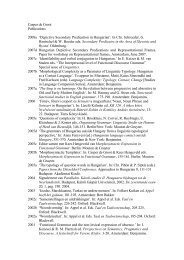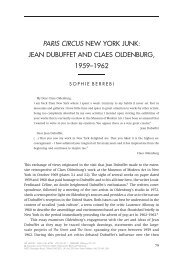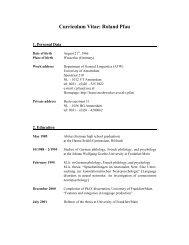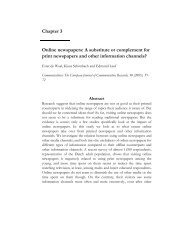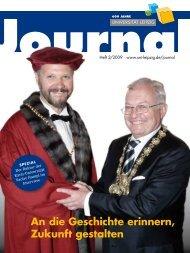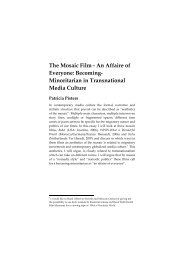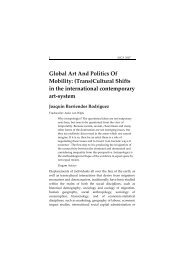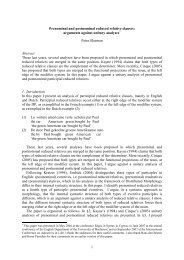Hyperdetermination in German Sign Language plurals
Hyperdetermination in German Sign Language plurals
Hyperdetermination in German Sign Language plurals
Create successful ePaper yourself
Turn your PDF publications into a flip-book with our unique Google optimized e-Paper software.
Pfau & Ste<strong>in</strong>bach: Under-, over-, and hyperdeterm<strong>in</strong>ation <strong>in</strong> DGS <strong>plurals</strong><br />
2 Various degrees of determ<strong>in</strong>ation <strong>in</strong> DGS <strong>plurals</strong><br />
→ In DGS, reduplication and zero mark<strong>in</strong>g are the two basic strategies of pluralization.<br />
Although some typological variation can be found, these are also the basic strategies for<br />
plural mark<strong>in</strong>g <strong>in</strong> other sign languages (for an overview see Pfau & Ste<strong>in</strong>bach 2005b). 2<br />
→ Reduplication is a very common morphological process <strong>in</strong> the grammar of sign languages<br />
(SLs). In DGS, reduplication is used for plural mark<strong>in</strong>g, aspectual mark<strong>in</strong>g, and<br />
reciprocal mark<strong>in</strong>g (cf. Pfau & Ste<strong>in</strong>bach 2003, 2005a).<br />
→ Plural reduplication comes <strong>in</strong> two forms: (i) simple and (ii) sideward reduplication.<br />
Moreover, reduplication <strong>in</strong> SLs usually does not only <strong>in</strong>volve one repetition but two.<br />
→ The choice of a particular plural mark<strong>in</strong>g strategy is determ<strong>in</strong>ed by phonological<br />
properties of the underly<strong>in</strong>g noun. Hence, we are deal<strong>in</strong>g with phonologically triggered<br />
allomorphy.<br />
2.1 Differentiation of noun types<br />
→ Four different k<strong>in</strong>ds of nouns need to be dist<strong>in</strong>guished: (i) nouns that are body-anchored<br />
(B-nouns), (ii) nouns <strong>in</strong>volv<strong>in</strong>g complex movement (C-nouns), (iii) nouns signed on the<br />
midsagittal plane (M-nouns), and (iv) nouns signed <strong>in</strong> the lateral sign<strong>in</strong>g space (L-nouns).<br />
→ Examples for each noun type are given <strong>in</strong> (4a) to (4d).<br />
(4) a.<br />
b.<br />
FRAU MANN FAHRRAD BUCH KIND<br />
‘woman’ ‘man’ ‘bicycle’ ‘book’ ‘child’<br />
B-noun C-noun M-noun L-noun<br />
→ B-nouns (4a) are related to a certa<strong>in</strong> body part. ‘Body-anchored’ does not necessarily<br />
imply contact with a body part, as is illustrated by the contrast between FRAU (‘woman’)<br />
and MANN (‘man’) where only the former makes contact with a body part.<br />
→ C-nouns (4b) are <strong>in</strong>herently specified for complex movement, where complex may mean<br />
circulat<strong>in</strong>g, alternat<strong>in</strong>g, or repeated. The noun FAHRRAD (‘bicycle’) is specified for all<br />
three of these features. Most C-nouns are two-handed signs.<br />
→ The M-noun BUCH (‘book) <strong>in</strong> (4c) is signed <strong>in</strong> neutral sign<strong>in</strong>g space and is specified for<br />
a particular relation to the midsagittal plane (<strong>in</strong>dicated by the dotted l<strong>in</strong>e). Most M-nouns<br />
are two-handed signs. They are signed symmetrically to or on the midsagittal plane.<br />
→ L-nouns (4d) are signed on the lateral side of the sign<strong>in</strong>g space, which is dependent on<br />
the handedness of the signer. As opposed to M-nouns, all L-nouns are one-handed signs.<br />
→ The figure <strong>in</strong> (5) gives an overview of the noun types that are relevant for the follow<strong>in</strong>g<br />
discussion of pluralization <strong>in</strong> DGS.<br />
2 See Wilbur (1987:124) and Valli & Lucas (1992:118) for ASL, Sutton-Spence & Woll (1999) for British SL,<br />
Skant et al. (2002:39f) for Austrian SL, Pizzuto & Corazza (1996) for Italian SL, Stavans (1996) for Israeli SL,<br />
Nijhof & Zwitserlood (1999) for SL of the Netherlands, and Zeshan (2000) for Indo-Pakistani SL.<br />
2<br />
2x<br />
c.<br />
d.






